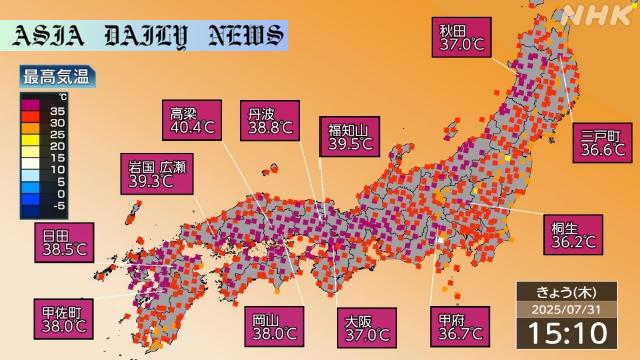Heatstroke: Scorching weather continues across Japan on Thursday, recording dangerous temperatures of over 40°C for a second day.

Record-Breaking Heat Hits Western Japan
For the second consecutive day, parts of western Japan are enduring life-threatening temperatures that have soared above 40 degrees Celsius. Takahashi City in Okayama Prefecture registered a staggering 40.4 degrees on Thursday afternoon, while other cities, including Fukuchiyama in Kyoto Prefecture and Akiota in Hiroshima Prefecture, also recorded dangerously high temperatures exceeding 39 degrees. Weather forecasts indicate that this scorching trend may persist in the coming days, prompting concern for public safety.
Heatstroke Alerts and Safety Precautions
In response to these extreme conditions, Japanese weather officials have issued heatstroke alerts across 34 of the country’s 47 prefectures. This warning underscores the severity of the situation, emphasizing the potential risks of prolonged exposure to such intense heat. Residents are urged to stay indoors as much as possible, utilize air conditioning to maintain cool indoor temperatures, and avoid outdoor activities during peak heat hours. Authorities also recommend staying hydrated with water and consuming adequate electrolytes to prevent dehydration and heat-related illnesses.
Broader Implications of Extreme Weather
The ongoing heatwave is a stark reminder of the broader challenges posed by climate change. Such extreme weather patterns not only endanger human health but also strain energy resources and disrupt daily life. In Japan, the rising demand for electricity to power air conditioning units has raised concerns about potential grid overloads. Moreover, prolonged heatwaves could adversely affect agriculture, leading to food supply issues. Experts stress the importance of proactive measures, such as urban greening and improved infrastructure, to mitigate the effects of rising global temperatures.
Looking Ahead
As Japan navigates through this challenging period, the immediate priority remains safeguarding lives. Public awareness campaigns, heat exhaustion education, and emergency services are critical to addressing the situation. Long-term, however, greater investment in sustainable practices and community resilience will be essential to combat the recurring impacts of extreme weather. This heatwave serves as a wake-up call, emphasizing the need for collective action to curtail the consequences of global warming and protect vulnerable populations.
Commentary
The Severity of the Situation
The recent spate of extreme heat in Japan is deeply concerning, not only for the immediate threat it poses to residents but for what it signifies in the broader context of climate change. Temperatures exceeding 40 degrees Celsius are not just uncomfortable – they are outright dangerous. The fact that multiple cities have recorded such highs underscores the urgency of addressing these issues at both local and global levels. Such conditions push the limits of human endurance and strain health infrastructure to its breaking point.
The Importance of Preparedness
Japan’s proactive approach to issuing heatstroke alerts and providing guidance is commendable. However, there is an inherent challenge in ensuring that all citizens, particularly the elderly and those in rural or underserved areas, have access to the resources they need to stay safe. This highlights the importance of community outreach and the role of local organizations in bridging gaps where government resources may fall short. The collective effort to combat this heatwave should serve as a model for other nations grappling with similar climate challenges.
Long-term Implications of Rising Temperatures
This heatwave is a sobering reminder of the long-term implications of climate change. While Japan is no stranger to hot summers, the intensity and frequency of such extreme weather events appear to be increasing. These conditions demand a rethinking of urban planning, energy usage, and public health strategies. Simple actions like planting more trees for shade or designing buildings with better heat resistance could go a long way in mitigating the effects of rising temperatures. However, this requires a coordinated effort between policymakers, scientists, and communities.


